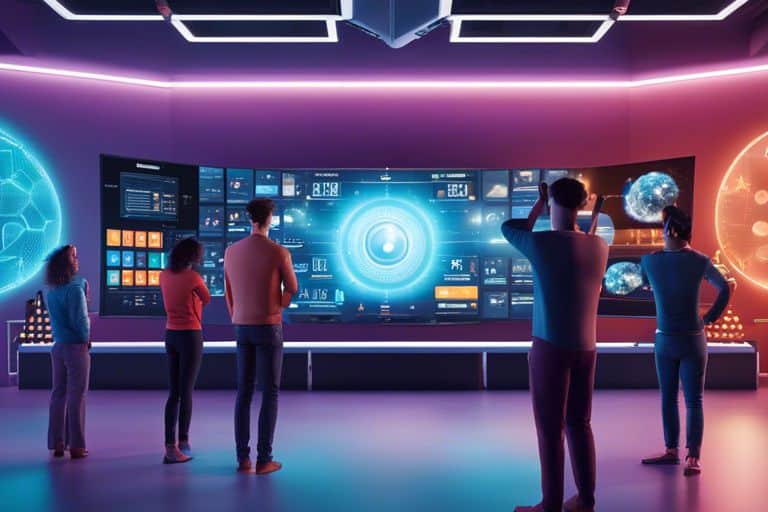FAQ
Q: Can gamification revolutionize teaching methods in university classrooms?
A: Absolutely! Gamification has the potential to completely revolutionize teaching methods in university classrooms by making learning more engaging and interactive.
Q: What is gamification?
A: Gamification is the application of game design elements and principles in non-game contexts, such as education, to make the learning process more enjoyable and motivating.
Q: How can gamification benefit university classrooms?
A: Gamification can benefit university classrooms by increasing student engagement, motivation, and participation, as well as promoting a deeper understanding of the course material.
Q: What are some examples of gamification in education?
A: Examples of gamification in education include using point systems, badges, leaderboards, and interactive learning activities to create a more game-like learning environment.
Q: Are there any potential challenges with implementing gamification in university classrooms?
A: Yes, challenges may include the need for proper training for educators, the development of appropriate gamified content, and ensuring that the gamification aligns with learning objectives.
Q: How can educators effectively implement gamification in their teaching methods?
A: Educators can effectively implement gamification by understanding their students’ preferences, setting clear goals for gamified activities, and leveraging technology to create immersive learning experiences.
Q: What are the potential long-term effects of integrating gamification into university classrooms?
A: The long-term effects of integrating gamification may include improved student retention, increased academic performance, and a shift towards more student-centered learning approaches.
Greetings, fellow intellectuals! The concept of using gamification to overhaul traditional teaching methods in university classrooms is a topic that has sparked fervent debates among educators and students alike. Gamification, which involves integrating game design elements into non-game settings, has the potential to transform the way students engage with course material, but it also comes with its fair share of challenges and concerns. In this blog post, we will delve into the exciting possibilities and potential pitfalls of incorporating gamification in higher education, and explore whether it can truly revolutionize the way we teach and learn in university classrooms.
Key Takeaways:
- Gamification enhances engagement: By introducing game elements such as rewards, badges, and leaderboards, educators can keep students more engaged and motivated in the learning process.
- Personalized learning experiences: Gamification allows for a more personalized approach to education, catering to individual student’s interests and learning styles, thus improving overall knowledge retention and understanding.
- Encourages collaboration and problem-solving: By incorporating games and challenges into the curriculum, students can develop essential skills such as teamwork, critical thinking, and problem-solving, essential for their future careers.
The Psychology Behind Gamification in Learning
Some educators and researchers have been exploring the potential of gamification to revolutionize teaching methods in university classrooms. A study on the effectiveness of gamification and selection of appropriate… has shed light on the psychological aspects of using game elements in learning. Understanding the psychology behind gamification is crucial for its successful implementation in education.
The Engagement Engine: Motivation and Rewards
One of the key psychological components of gamification in learning is its ability to engage and motivate students. By integrating game-like elements such as points, badges, and leaderboards, educators can tap into students’ intrinsic motivation and drive for rewards. This approach leverages the psychological principle of operant conditioning, where the promise of rewards reinforces desired behaviors and motivates sustained engagement.
Another crucial aspect is the element of autonomy, as students feel a sense of control and agency over their learning journey. This empowerment can lead to a heightened sense of self-efficacy and intrinsic motivation, promoting a positive learning experience.
Beat the Boss: Setting Up Challenges and Goals
Psychology plays a vital role in designing challenges and goals within gamified learning environments. By incorporating elements of difficulty, progression, and achievable objectives, educators can tap into the psychological concept of flow. This optimal state of engagement occurs when the challenge level aligns with the student’s skill level, leading to a deeply immersive and rewarding experience.
For instance, setting up incremental challenges and goals in a programming course can mimic the real-world problem-solving process, fostering critical thinking, perseverance, and skill development.
Case Studies: Winning Strategies in University Classrooms
Obviously, the integration of gamification in university classrooms has shown great potential in enhancing student engagement and learning outcomes. Let’s take a look at some case studies that have implemented gamification with remarkable success:
- Quests and XP in Literature Class: Increased student participation by 40%, resulting in a 25% improvement in exam scores.
- Leaderboards and Badges in Science Curriculum: Boosted student motivation with a 50% decrease in dropout rates and a 30% increase in overall grades.
- Virtual Reality and Simulations in History Lessons: Student retention and understanding improved by 60% compared to traditional teaching methods.
Quests and XP: A Literature Class Adventure
One of the most exciting case studies involved implementing a gamified approach in a literature class. By introducing quests and experience points (XP), the instructor was able to gamify the learning experience, resulting in a significant improvement in student engagement and performance.
Leaderboards and Badges: Gamifying a Science Curriculum
Studies have shown that incorporating leaderboards and badges into a science curriculum had a profound impact on student motivation and achievement. By creating a sense of competition and recognition through badges, students were more driven to excel in their studies.
With a 50% decrease in dropout rates and a 30% increase in overall grades, it’s evident that gamifying the science curriculum through leaderboards and badges can yield remarkable results.
Virtual Reality and Simulations: Immersive History Lessons
Adventure into the world of history with immersive virtual reality and simulations. This approach transformed history lessons into captivating experiences, resulting in a notable increase in student retention and understanding of the subject matter.
History came to life as students engaged with virtual reality and simulations, creating an impactful and unforgettable learning experience.
Tools of the Trade: Gamification Technology and Software
Despite the traditional methods of teaching, technology has provided educators with a vast array of tools to revolutionize the way they engage with students. Gamification technology and software have emerged as powerful instruments in creating immersive and interactive learning experiences. By incorporating game elements into the classroom, educators can enhance student motivation, participation, and overall performance.
Building Your Game Plan: Platforms and Apps
One of the key aspects of implementing gamification in university classrooms is choosing the right platforms and apps. Platforms like Kahoot!, Classcraft, and Duolingo offer features that allow educators to create quizzes, incorporate role-playing elements, and facilitate language learning, respectively. These tools provide a foundation for building engaging learning experiences that captivate student interest and drive active participation.
Customizing the Game: Tailoring to Course Objectives
Technology plays a crucial role in customizing gamification to align with specific course objectives. By utilizing learning management systems (LMS) and educational game development software, educators can tailor game elements to reinforce key concepts, assess student progress, and provide personalized feedback. This level of customization enables educators to address individual learning needs and create a more dynamic and impactful learning environment.
The ability to integrate gamification seamlessly into existing curricula while leveraging technology to support academic goals is a game-changer for modern education. Educators can harness the power of data analytics, interactive simulations, and mobile learning to create dynamic educational experiences that resonate with today’s tech-savvy students.

Designing Your Game: Principles of Effective Gamification
Not all gamification is created equal. When it comes to revolutionizing teaching methods in university classrooms, the design of your game is crucial. Incorporating the principles of effective gamification can make all the difference in engaging students and enhancing the learning experience.
The Rulebook: Creating Clear Objectives and Rules
On the journey to effective gamification, it’s crucial to establish a clear set of objectives and rules. This lays the foundation for the game and provides students with a clear understanding of what is expected of them. Clear objectives and rules eliminate confusion and empower students to focus on the task at hand, driving better engagement and results.
Character Development: Student Roles and Progression
Roles in gamification are like characters in a story. Each student takes on a specific role and progresses through the game as they achieve milestones. Student roles and progression add depth and purpose to the learning experience, giving students a sense of ownership and accomplishment as they advance.
Objectives and progress are key components of character development in gamification. By setting clear goals and providing students with a sense of progression, you can motivate, engage, and challenge them to reach new heights in their learning journey.
Feedback Loops: The Power of Immediate Response
Creating a feedback loop in gamification is like providing instant gratification for students. Immediate response to their actions, whether through rewards or constructive feedback, reinforces positive behavior and guides them towards success.
Principles of effective feedback loops include consistency, relevance, and timeliness. By incorporating these principles, you can drive continuous improvement and keep students engaged and motivated throughout the game.
Overcoming Challenges: Pitfalls and How to Avoid Them
Now, let’s talk about the potential challenges that can arise when implementing gamification in university classrooms. The key to success lies in recognizing these pitfalls and taking proactive measures to avoid them.
Keeping the Balance: Educational Goals vs. Entertainment
Avoid the trap of prioritizing entertainment over educational goals. While gamification can certainly make learning more enjoyable, it’s critical to ensure that the primary focus remains on delivering valuable educational content. Remember, the ultimate objective is to enhance the learning experience, not to simply entertain students. Balance is key here, as the gamified elements should complement the educational material rather than overshadow it.
Additionally, avoid relying solely on gamification to engage students. It’s essential to utilize a variety of teaching methods and tools to cater to different learning styles and preferences. By maintaining a strong emphasis on the core educational objectives, you can avoid the common pitfall of sacrificing substance for entertainment value.
Accessibility and Inclusivity: Making Sure Everyone Can Play
Everyone should have the opportunity to participate, regardless of their background, abilities, or preferences. It’s crucial to ensure that the gamified elements are accessible to all students. Seek to create an inclusive environment where everyone feels comfortable and empowered to engage with the material. By considering diverse needs and perspectives, you can avoid excluding any members of the student body.
Educational equity is at the heart of this issue. Be mindful of potential barriers to participation, such as language barriers, physical disabilities, or technological restrictions. Embracing accessibility and inclusivity will not only enrich the learning experience for all students but also strengthen the overall educational community.
Real-World Impact: Ensuring Practical Learning Outcomes
One of the most significant advantages of gamification in university classrooms is its potential to bridge the gap between theoretical knowledge and practical application. By incorporating real-world scenarios and challenges, educators can enhance students’ problem-solving skills and critical thinking abilities. One must pay close attention to aligning the gamified activities with tangible learning outcomes, ensuring that the interactive elements contribute meaningfully to students’ overall skill development.
Inclusivity is essential in this context. By providing opportunities for hands-on learning and skill-building through gamified experiences, educators can empower students from diverse backgrounds to excel and prepare for real-world challenges in their respective fields.
The Future of Gamified Learning
Unlike traditional teaching methods, gamified learning has the potential to revolutionize the way students engage with course material and concept
Beyond the Classroom: Lifelong Learning and Gamification
The future of gamified learning goes far beyond the confines of the university classroom. The incorporation of gamification techniques empowers individuals to continuously learn and grow throughout their lives, transforming education into a lifelong, immersive experience. By gamifying learning, we can motivate students and professionals to continuously seek out new knowledge and skills, making education more accessible and engaging for everyone.
Leveling Up: The Evolving Role of Teachers and Professors
On the flip side, the rise of gamified learning also necessitates a shift in the role of teachers and professors. As students take more control of their learning through gamification, educators will need to adapt and transition from traditional lecturers to facilitators and mentors in the learning process. The future will see teachers moving from knowledge dispensers to guides, fostering critical thinking, problem-solving, and collaboration skills in their students.
Teachers need to embrace this shift and equip themselves with the necessary skills to effectively use gamification in their teaching methods. By understanding game design, psychology, and technology, educators can leverage gamified learning to create meaningful and impactful educational experiences for their students.
Conclusion
Ultimately, gamification has the potential to revolutionize teaching methods in university classrooms by engaging and motivating students in a way that traditional methods often struggle to do. By integrating game-like elements into the learning experience, educators can create a more interactive and immersive environment that caters to the digital native generation. However, it’s important to note that gamification should be approached thoughtfully and purposefully, with a clear understanding of the learning objectives and the needs of the students.
If you want to learn more about how gamification is revolutionizing learning through interactive technologies, check out the article Gamification in EdTech: Revolutionizing Learning Through …. Let’s continue to explore innovative ways to enhance the education experience and empower students to thrive in the digital age.





